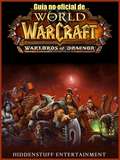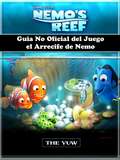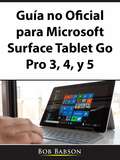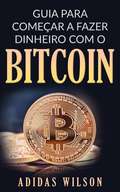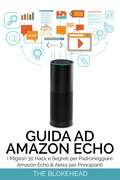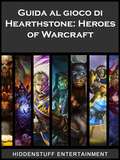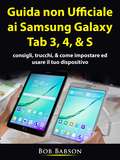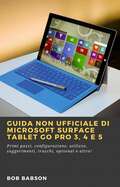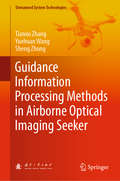- Table View
- List View
Guía No Oficial de Pet Rescue Saga
by Carme Folch Joshua AbbottGuía No Oficial de videojuego Pet Rescue Saga.
Guía no oficial de World of Warcraft: Warlords of Draenor
by Isabel Mª Garrido Bayano Joshua Abbott*GUÍA NO OFICIAL* Guía de estrategia y consejos avanzados. Esta es la guía más detallada y completa que encontrarás online. Está disponible para descarga instantánea en tu teléfono móvil, dispositivo eBook o libro de bolsillo. Tras el éxito de mis cientos de guías y estrategias he escrito otra guía profesional avanzada para jugadores nuevos y veteranos. Te proporciona estrategias específicas y consejos sobre cómo progresar en el juego, vencer a tus enemigos, conseguir más monedas, ¡y mucho más! - Consejos y estrategias profesionales. - Trucos y hacks. - Secretos, consejos, trucos y objetos desbloqueables que usan los jugadores profesionales. - Cómo conseguir montones de dinero. - ¡Y MUCHO MÁS! Descargo de responsabilidad: Este producto no está asociado, afiliado, respaldado, certificado o patrocinado por el propietario del Copyright original.
Guia No Oficial del Juego el Arrecife de Nemo
by Adriana Rojas The YuwGuía avanzada de tips y estrategias. Esta es la única guía más comprensible y detallada que podrás encontrar en línea. Disponible para descargarse instantáneamente en tu teléfono móvil, equipo de libros electrónicos, o en un formato de papel. Con el éxito de cientos de otras guías escritas y estrategias que he escrito otra guía profesional avanzada para jugadores nuevos y veteranos. Esta da estrategias específicas y tips en cómo avanzar en el juego, vencer a tu oponentes, adquirir más moneras y dinero, mas ¡muchas otras cosas! - Tips y estrategias profesionales. - Trucos y consejos. - ¡Secretos, Tips, Mañas, Desbloqueadores, and Trucos usados por los jugadores profesionales! - Como obtener miles de Dinero/Monedas. - ¡Y MUCHO MÁS! Todas las versiones de esta guía tiene impresiones de pantalla para ayudarte a un mayor entendimiento del juego. No hay otra guía que sea tan comprensible y avanzada como esta.
Guía no Oficial Descargable para Hacks, Mods, Apk, Wiki del Juego Family Guy en Busca de Cosas
by Joshua Abbott Roberto Vega MauryBreve guía descargable con trucos y estrategías para obtener un gran dominio del juego Family Guy: en busca de cosas.
Guía no Oficial para Microsoft Surface Tablet Go Pro 3, 4, y 5
by Bob BabsonAprenda de manera sencilla y rápida como sacar mayor provecho a los dispositivos Microsoft Surface Go Pro 3, 4 y 5, y disfrutar al máximo de sus capacidades y posibilidades.
Guía Para El Autor Independiente: Cómo Crear, Publicar Y Promocionar Tu Libro Para Kindle
by Nick Vulich Natalia SteckelIndie Author's Toolbox fue escrito tanto para autores nuevos como para autores experimentados. Es una guía para optimizar tu libro para Kindle, pero eso no es todo. Demasiados autores consideran a Kindle como la meta final de sus libros. Están tan inmersos en optimizar su libro para Amazon, lanzar KDP Free Days, Countdown Deals, y variar sus precios que se olvidan de una cosa: millones de personas nunca han comprado un libro para Kindle, ni ningún otro tipo de libro electrónico. Es cierto: Amazon es el chico grande de la cuadra. Se calcula que tienen el 65 % del mercado de libros electrónicos en Estados Unidos. Sin embargo, si sé hacer las cuentas, eso deja un 35 % de lectores estadounidenses que disfrutan sus libros electrónicos servidos de otra manera. ¿Puedes darte el lujo de ignorarlos? La iStore de Apple es el segundo mercado de libros electrónicos más grande del mundo. Kobo tiene una presencia fuerte en Canadá y en muchos otros países. Barnes and Noble aún conserva más del 15 % del mercado. Además, no nos olvidemos de que a muchos lectores todavía les gustan los libros a la antigua: en papel que puedan pasar con los dedos, con esquinas que puedan doblar y márgenes que puedan escribir. Hay millones de lectores que prefieren escuchar un libro en lugar de leerlo. Si no tienes tu libro en ACX, estás perdiendo millones de lectores potenciales que compran en Audible, Amazon y en la iStore. ¿No me crees? Considera lo siguiente: durante mi primer mes en ACX vendí más de 200 audiolibros, con cuatro títulos disponibles. En el próximo mes espero tener los 22 títulos en audiolibros y obtener alrededor de 1000 ventas por mes. Todo lo que me costó fue un simple Fiverr para crear la tapa de cada audiolibro. Para los adictos a Amazon, también voy a brindarles algo de información que puede ayudarlos.¡Oye! ¿Quieres saber un secreto? No hay secretos.
Guia para Começar a Fazer Dinheiro com O Bitcoin
by Adidas Wilson John Klebison FerreiraO Bitcoin é uma criptomoeda e um sistema de pagamentos digital criado por um programador desconhecido, ou por um grupo de programadores, sob o nome de Satoshi Nakamoto. Foi lançado como software open-souce em 2009. É um sistema peer-to-peer (ponto-a-ponto), e as transações ocorrem diretamente entre usuários sem a necessidde de um intermediário. Essas transações são verificadas por nodos de rede e registradas em uma espécie de livro público conhecido como blockchain. Uma vez que sistema funciona sem a intervensão de uma entidade central ou administrador superior e único, o bitcoin é chamado de primeira moeda digital descentralizada. Além de poder ser criado como recompensa pela mineração, o bitcoin pode ser trocado por outras moedas, produtos e serviços em qualquer tipo de de mercado.
Guía para principiantes. Hacer dinero con tu pequeña empresa en las redes sociales
by E2e Alex Nkenchor UwajehLas redes sociales ofrecen gran variedad de posibilidades para pequeñas empresas. No solo son una forma barata de dar a conocer tu marca y tus productos, sino que son también una vía excelente para atraer nuevos clientes. La clave del éxito está en entender las diferentes formas de beneficiarte de cada red social.
Guía para sobrevivir al presente: Atrapados en la era digital
by Santiago BilinkisSantiago Bilinkis aborda en su nuevo libro un tema central del presente: cómo esa supercomputadora de bolsillo que es el teléfono celular está afectando nuestras vidas. El impacto de las nuevas tecnologías sobre el cerebro, la educación, el trabajo y el uso del tiempo libre, bajo la mirada del autor de Pasaje al futuro. ¿Qué impacto tienen los aparatos digitales sobre nuestras vidas?¿Qué efectos produce su uso permanente en nuestros cerebros y los de nuestros chicos?¿Por qué pasamos tanto tiempo atrapados en las redes? Basta alzar la vista para corroborarlo: hoy vivimos mirando el celular. Y no es casual: científicos y empresas trabajan intensamente para aprovechar los últimos avances en neurociencia y psicología y profundizar la dependencia con sus sitios y aplicaciones. Con el objetivo de incrementar sus ganancias, las principales compañías de tecnología se encuentran en una guerra por conquistar nuestro tiempo. Y la están ganando: sin siquiera darnos cuenta, desbloqueamos el celular 120 veces al día. Esta es la primera vez que una herramienta, apenas comenzamos a usarla, empieza a usarnos a nosotros. ¿Cuál es el resultado de esta manipulación? Niños enchufados a las pantallas a edades cada vez más tempranas; redes sociales y aplicaciones de citas que vapulean la autoestima de adolescentes y adultos; numerosas personas que, enganchadas en un consumo maratónico de series, reducen al mínimo su descanso. La tentadora promesa de novedades permanentes esconde una trampa detrás de cada app, a menudo a costa de nuestros intereses prioritarios y hasta de nuestra salud. Develando los mecanismos que han convertido al celular en un objeto irresistible, Santiago Bilinkis propone en esta Guía para sobrevivir al presente una manera apasionante de desbloquear nuestra ingenuidad frente a los dispositivos. Y nos ofrece ideas para utilizar los aparatos digitales para conectarnos y vivir experiencias compartidas en vez de encerrarnos en nuestra propia pantalla. En definitiva, nos invita a recuperar el control sobre la vida personal, familiar y laboral, y así disfrutar de los beneficios y las oportunidades que brinda la tecnología sin quedar atrapados en ella.
Guía Paso a Paso para Desbloquear Fire Stick Alexa TV
by Jonathan GatesGuía que explicará paso a paso como desbloquear su TV utilizando Fire Stick Alexa en sencillos pasos.
Guia Pokémon GO + 20 dicas e truques que você deve ler
by Game Guidez Fernanda Ranieri SilvaSeja o melhor treinador Pokémon você pode ser! Em nosso guia, mergulhamos diretamente nas dicas e truques que o ajudarão a se tornar um mestre no menor tempo possível. Nós o guiamos de mãos dadas com algumas das dicas mais cobiçadas e truques descobertos no jogo até agora. Se você quiser acelerar a sua diversão, este é o livro para ir para você! Alguns dos tópicos que abordamos: Começando Encontrando mais pokémons Nivelamento mais rápido e mais eficiente Como encontrar Pokémon em uma equipe Como economizar bateria com estratégias avançadas Itens Dicas e truques de Realidade Aumentada Dicas especiais do Pokéstop Segredos e sugestões Também estão incluídos muito mais dicas, truques e segredos. Se você quiser ler nenhuma enrolação e apenas chegar direto ao ponto, este é o livro para você! Leia a sua cópia hoje e torne-se o mestre que você é!
Guia Prático das Câmeras GoPro Hero e Fusion: Como usar a sua GoPro Fusion e Hero 4/5/6/7 disponíveis em Black e White
by Brad JohnsonAprenda a usar a sua câmera GoPro como um profissional! Este guia é para quem procura capturar vídeos incríveis em seu dispositivo GoPro. Compatível com GoPro Fushion, Hero 4,5,6 e 7. Este livro aborda tudo o que você precisa saber: - Tirar fotos e vídeos incríveis - Fotos de lapso de tempo - Fotografia em movimento - Compartilhando seus vídeos e fotos - Fotografia subaquática - Composição das filmagens - Uso da bateria - Resolução e campo de visão - Uso do estabilizador Gimbal - Técnicas de edição de vídeo - E MAIS!
Guía simple para usar el iPhone 12, Mini, Pro, y Pro Max: Manual de usuario simplificado para principiantes – incluye tips y trucos útiles.
by Dylan Blake Patrick Garner¿Eres un adulto mayor o alguien que busca una guía fácil paso a paso? Entonces, ¡no busques más! Si estás leyendo esto es porque tienes uno de los más recientes teléfonos insignia de Apple, y ahora que ya tienes esta belleza, es hora de darle buen uso a todo lo que te ofrece, usando un muy bien ilustrado manual de usuario que devela todos sus tips y trucos ocultos. Esta guía ha sido elaborada de forma especial para darte exactamente lo que necesitas, con muchos tips y trucos para ayudarte a familiarizarte con el iPhone 12, el iPhone 12 Mini, el iPhone 12 Pro y el iPhone 12 Pro Max. Si tienes un modelo de iPhone anterior, no tienes por qué sentirte excluido porque también hemos escrito esta guía pensando en ti.Los modelos iPhone 12 tienen incorporadas funciones que te podrían hacer agua la boca. Llevan incluido el nuevo y más rápido chip A14 Bionic, que ofrece una grandísima mejora en rendimiento. Son los primeros teléfonos móviles capaces de grabar vídeo con Dolby Vision en tiempo real, un formato de vídeo profesional. También incorporan pantallas OLED Super Retina XDR con una cubierta Ceramic Shield para mejorar la durabilidad y una protección contra caídas 4 veces mayor. También incorporan los cargadores inalámbricos MagSafe (un sistema de carga inalámbrica magnética) que es dos veces más rápido que los anteriores cargadores inalámbricos Qi. Con este libro podrás aprovechar al máximo todas las funciones y capacidades de tu dispositivo ¡y más! Una vez tengas este libro, aprenderás a: • Encender y configurar tu iPhone • Configurar tus servicios celulares • Instalar una tarjeta nano-SIM física • Configurar un plan de datos celulares con una tarjeta eSIM • Administrar tus planes celulares para SIM doble • Conectar tu iPhone a internet • Cambiar de un dispositivo Android a un iPhone • Administrar la configuración de tu Apple ID y iCloud en el iPhone • Activar y desbloquear tu iPhone •
Guía simple para usar el iPhone 13, Mini, Pro, y Pro Max: Manual de usuario simplificado para principiantes y adultos mayores- incluye tips y trucos útiles
by Dylan Blake¿Eres un ADULTO MAYOR o un PRINCIPIANTE? ¿Deseas sacarle el mejor provecho a tu iPhone? ¡Recibe la ayuda que necesitas con esta guía simplificada! Los nuevos modelos de iPhone 13 vienen repletos de nuevas funciones que puedes utilizar en tu día a día, y este manual de usuario es tu ticket para explorarlas. ¿Quieres usar la cámara de forma más eficiente? ¿Quieres configurar una ficha médica para emergencias? ¿O quieres hacer varias tareas básicas como enviar un mensaje de texto, hacer una llamada, llamar por FaceTime a un amigo, etc.? Entonces, esta práctica guía puede ayudarte con todo eso y mucho más. Al comprar este libro, aprenderás a: • Encender y configurar tu iPhone • Configurar tus servicios celulares • Instalar una tarjeta nano-SIM física • Configurar un plan de datos celulares con una tarjeta eSIM • Administrar tus planes celulares para SIM doble • Conectar tu iPhone a internet • Cambiar de un dispositivo Android a un iPhone • Administrar la configuración de tu Apple ID y iCloud en el iPhone • Activar y desbloquear tu iPhone • Usar gestos y trucos para modelos de iPhone con Face ID • Ajustar el volumen de tu iPhone • Cambiar los sonidos de alertas y las vibraciones de tu iPhone • Buscar configuraciones en tu iPhone • Ampliar el contenido de la pantalla de tu iPhone con Tamaño de pantalla • Abrir apps en el iPhone • Cambiar entre apps • Organizar tus apps en carpetas • Tomar una captura de pantalla o grabar la pantalla en tu iPhone • Bloquear o desbloquear la orientación de la pantalla en tu iPhone • Moverte por la pantalla de fotos de la cámara • Moverte por la pantalla de vídeos de la cámara • Grabar con efecto Cine • Grabar vídeos ProRes • Escanear un código QR con la cámara del iPhone • Ver fotos y vídeos en el iPhone • Eliminar y ocultar fotos y vídeos en el iPhone • Editar fotos y vídeos en el iPhone • Administ
Guida ad Amazon Echo: I Migliori 30 Hack e Segreti per Padroneggiare Amazon Echo & Alexa per Principianti
by The BlokeheadLa Perfetta Guida ad Amazon Echo! Questo libro è un compagno comodo e completo che vi permetterà di installare ed usare il vostro Amazon Echo in modo veloce ed efficiente, senza conoscenze di base. Leggendo questo libro conoscerete e sarete in grado di approfittare di tutti i benefici che questo magnifico oggetto ha da offrire, permettendovi di concentrarvi sui vostri impegni quotidiani. Imparerete a: 1. Hackerare il telecomando 2. Controllare finti dispositivi WEMO 3. Controllare Luci e Temperatura 4. Conoscere i Migliori Comandi 5. E Molto Altro! Scaricatelo ORA e Iniziate a Leggere!
Guida al gioco di Hearthstone: Heroes of Warcraft
by Hiddenstuff Entertainment Josh Abbott Stefano VazzolaGrazie alla mia guida al gioco capirai esattamente ciò che devi sapere per diventare un giocatore esperto e sconfiggere gli avversari! È una guida completa con tutto ciò che devi sapere sul gioco. Inoltre potrai anche scaricare una copia gratuita del gioco insieme a questo acquisto. - Suggerimenti e strategie professionali. - Cheat e trucchi. . Tutto sulle classi Eroe. - Tutto sulle Missioni e le Imprese. - Tutto sulla creazione del mazzo. - Tutto sulla creazione delle carte. - Segreti, suggerimenti, cheat, carte da sbloccare e trucchi usati dai giocatori esperti! - Informazioni e strategie con spiegazioni dettagliate. - Strategie generiche per principianti. - E MOLTO ALTRO ANCORA! Acquistalo ora e distruggi gli avversari! Diventa subito un giocatore esperto! Disclaimer: il presente prodotto non è associato, affiliato, approvato, certificato o finanziato da Blizzard Entertainment. La presente guida si propone come riferimento e non va a modificare in nessun modo il gioco. La presente è una guida scritta e non un programma software.
Guida alla Disintossicazione Digitale: Sconfiggi le dipendenze dai social media
by Gary RandolphSebbene i social media siano un ottimo strumento per comunicare con i tuoi amici, la tua famiglia, cercare conoscenze e informazioni, utilizzarli 24 ore su 24, 7 giorni su 7, non fa bene alla salute mentale. Oggi le persone sono diventate dipendenti dai social media e gli stessi hanno anche ridotto l'attività fisica delle persone. Se sei diventato dipendente dai social media e vuoi cambiare le tue preferenze sulla vita, questa guida fa per te. Questa guida ebook descrive il processo completo di disintossicazione digitale. Se vuoi sbarazzarti dalla dipendenza dai social media, questa guida fa per te. Questa guida ebook ti insegnerà: - I dieci modi migliori per sbarazzarsi della dipendenza dai siti social - Quali account devono essere cancellati - Come mantenere l'account con un utilizzo minimo - Come limitare la tua lista di amici - Come utilizzare al minimo il tuo dispositivo - Il riallineamento delle tue priorità - Come trovare tempo libero per le tue relazioni reali - I passi da compiere - & molto di più!!! --> Scorri fino alla parte superiore della pagina e fai clic su aggiungi al carrello per acquistare immediatamente
Guida non ufficiale ai Samsung Galaxy Tab 3, 4, & S: consigli, trucchi, & come impostare ed usare il tuo dispositivo
by Hiddenstuff EntertainmentUsi il tuo dispositivo Samsung regolarmente? Vorresti imparare ad utilizzare il tuo dispositivo Samsung come un professionista e risparmiare tantissimo tempo? Compatibile con tutte le versioni 3, 4, e S. Se hai risposto sì ad una di queste domande, allora questo manuale è per te. Sapevi che il tuo dispositivo Samsung è in grado di svolgere centinaia di funzioni, tutte capaci di renderti la vita più semplice e farti risparmiare moltissimo tempo? Ad ogni modo, visto che ci sono una marea di funzioni segrete, può essere difficile sapere esattamente come ottimizzare l'uso del tuo dispositivo. Cos'è compreso: -Come impostare il dispositivo. -Come navigare. -Capacità del dispositivo. -Come risparmiare tempo. -Come evitare sforzi e completare compiti facilmente. -Imparare ad usare il dispositivo come un professionista. -Risoluzione dei problemi. + MOLTO ALTRO! Se vuoi imparare ad utilizzare il tuo dispositivo come un professionista, questo manuale è per te. --> Vai in cima alla pagina e clicca su aggiungi al carrello per acquistare immediatamente Disclaimer: This author and or rights owner(s) make no claims, promises, or guarantees in regards to the accuracy, completeness, or adequacy of the contents of this book, and expressly disclaims liability for errors and omissions in the contents within. This product is for reference use only. Please consult a professional before taking action on any of the contents found within.
Guida Non Ufficiale Al Gioco Nemo's Reef
by The Yuw Wanda SalatinoGuida avanzata di trucchi e consigli. Si tratta dell'unica e più esaustiva guida repreibile online. Disponibile per il download automatico direttamente sul tuo cellulare, sul dispositivo eBook device, o in forma cartacea. Dall'esperienza di centinaia di altre guide e strategie pubblicate, ecco un'altra guida professionale per giocatori novizi o veterani. La guida fornisce strategie e suggerimenti specifici su come andare avanti nel gioco, battere gli avversari, guadagnere crediti e molto altro! - Suggerimenti e strategie professionali - Trucchi e Hack - Segreti, consigli, trucchi, obiettivi sbloccabili utilizzati dai giocatori professionisti! - Come ottenere una montagna di crediti - E MOLTO ALTRO! Tutte le versioni di questa guida sono corredate da screenshot per aiutarti a capire meglio il gioco. Non esiste altra guida così completa ed esaustiva! Disclaimer: Questo prodotto non è associato, affiliato, approvato o sponsorizzato dal/i proprietario/i originale/i del copyright.
Guida Non Ufficiale Color Switch
by Martina Simonetti The YuwLa Guida Non Ufficiale di Color Switch è un eccellente manuale contenente tutte le informazioni di cui avete bisogno per giocare e non solo! Nel presente libro troverete una guida dettagliata e illustrata per installare il gioco su ogni dispositivo disponibile, dopodiché una sezione apposita vi mostrerà ogni aspetto del gioco e del suo funzionamento, incluse le varie modalità esistenti. Infine, vi saranno offerti una serie di consigli e trucchetti per poter superare i livelli e guadagnare punti più facilmente! Alla fine del libro troverete anche un Bonus lettore, che vi è offerto gratuitamente da HiddenStuff Entertainment. Buona lettura!
Guida non ufficiale di Microsoft Surface Tablet Go Pro 3, 4 e 5: Primi passi, configurazione, utilizzo, suggerimenti, trucchi, optional e altro!
by Bob BabsonSei una persona che utilizza regolarmente Microsoft Surface? Ti piacerebbe imparare a utilizzare i dispositivi Microsoft Surface come gli smanettoni e risparmiare un sacco di tempo? Guida compatibile con tutte le versioni Go e Pro 2, 3 e 4. Se la tua risposta è sì, allora questa guida fa per te. Sapevi che il tuo dispositivo Microsoft Surface ha migliaia di funzioni che possono semplificarti la vita? Tuttavia, contiene tante funzioni nascoste, perciò non è molto semplice saper utilizzare sempre il dispositivo in modo ottimale. La guida ti spiegherà: -come configurare il dispositivo -come navigare su internet -le funzionalità del dispositivo -come risparmiare tempo -come risparmiare energie e svolgere lavori senza problemi -come utilizzare il tuo dispositivo come gli smanettoni -come gestire i problemi + E MOLTO ALTRO! Se vuoi imparare a utilizzare il tuo dispositivo come uno smanettone, questa guida fa per te. --> Torna in cima alla pagina e clicca subito Aggiungi al carrello per acquistare subito il libro Disclaimer: L'autore e/o il detentore della proprietà intellettuale non compie alcuna rivendicazione né rilascia alcuna promessa o garanzia in merito all'accuratezza, completezza o adeguatezza dei contenuti di questo libro e declinano espressamente la responsabilità su eventuali errori e omissioni nei contenuti proposti.
Guida non ufficiale di World of Warcraft: Warlords of Draenor
by Stefano Vazzola Joshua Abbott*GUIDA NON UFFICIALE* Guida avanzata con suggerimenti e strategie. Questa è la guida più esaustiva e dettagliata che puoi trovare online. Disponibile per lo scaricamento immediato sul telefono cellulare, sul lettore di e-book o in forma cartacea. Dopo il successo delle centinaia di altre guide e strategie, ho scritto l'ennesima guida professionale avanzata per i giocatori principianti e veterani. Fornisce strategie e suggerimenti specifici su come avanzare nel gioco, battere gli avversari, acquisire più monete e denaro, e molto altro ancora! - Suggerimenti e strategie professionali. - Cheat e trucchi. - Segreti, suggerimenti, cheat, carte da sbloccare e trucchi usati dai giocatori esperti! - Come ottenere una marea di Denaro/Monete. - E MOLTO ALTRO ANCORA! Tutte le versioni della presente guida dispongono di immagini di schermate come supporto per comprendere meglio il gioco. Non esiste alcuna altra guida esaustiva e avanzata come questa. Disclaimer: il presente prodotto non è associato, affiliato, approvato, certificato o finanziato dal Proprietario Originale del Copyright.
Guida non ufficiale per pet rescue saga
by Chiara Laguardia Joshua AbbottUnofficial guide for Pet rescue saga, one of the most popular game nowadays for smartphone and computer
Guidance Information Processing Methods in Airborne Optical Imaging Seeker (Unmanned System Technologies)
by Tianxu Zhang Yuehuan Wang Sheng ZhongThis book covers all main aspects of guidance information processing technologies for airborne optical imaging seekers, including theoretical models; image pre-processing; automatic target detection, recognition and tracking; and embedded real-time processing systems. The book is divided into three major sections: firstly, a theoretical model for optical-seeker information processing is introduced; then information processing methods are presented, including target modeling, online image pre-processing, typical surface fixed-target detection and recognition, and moving-target detection and recognition; lastly, embedded real-time processing systems are introduced, including new system architectures, image processing ASIC/SoC design, embedded real-time operating systems, system implementation aspects, and system testing and evaluation technologies. The book offers a unique and valuable resource, helping readers understand both fundamental and advanced information processing technologies employed in airborne optical imaging seekers.
Guide de désintoxication numérique: Surmonter les addictions aux réseaux sociaux
by Gary RandolphMême si les réseaux sociaux constituent d’importants outils de communication avec les amis et la famille et qu’ils sont un moyen indispensable de recherche de savoir et d’informations, leur utilisation 24/7 n’est pas conseillée pour la santé mentale. Aujourd’hui, des personnes sont devenues dépendantes des réseaux sociaux, entraînant une baisse considérable de l’activité physique chez celles-ci. Si vous êtes devenus dépendants des réseaux sociaux et désirez changer vos préférences de vie, le présent guide vous est destiné. Le présent guide électronique décrit le processus complet de désintoxication numérique. Si vous désirez surmonter l’accoutumance aux réseaux sociaux, le présent guide est pour vous. Le présent guide électronique vous apprendra : - Les dix meilleures méthodes pour vaincre l’accoutumance aux sites sociaux - Quels comptes méritent d’être supprimés - À tenir compte de l’utilisation minimale - Comment réduire la liste de vos amis - L’utilisation minimale des appareils - À réorienter vos priorités - À dégager du temps libre pour vos véritables relations - La démarche à suivre - Et plus encore ! --> Défilez vers le haut de la page et cliquez sur ajouter au panier pour acheter instantanément

